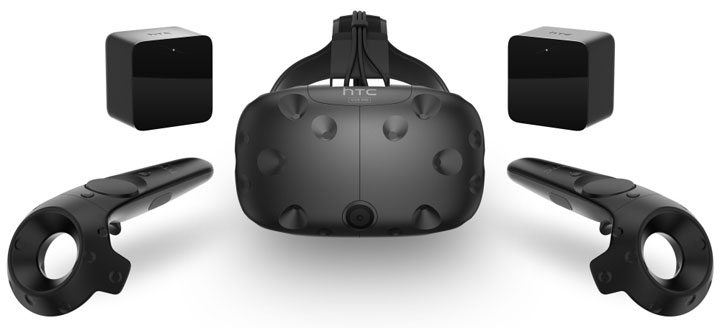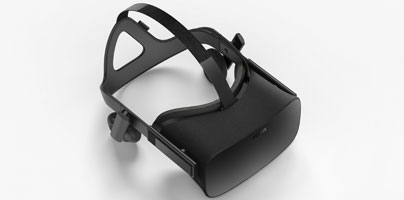Pictured above is the Oculus VR, the famed virtual reality (VR) headset that just started shipping. By now, I’m sure you know pretty much all there is to know about it: that it is priced at $600, that it requires a pretty powerful computer, that there’s a tool that checks your computer to see if it can handle the Oculus Rift, that 30 Oculus Rift games are available from day one, with a hundred more coming later this year.
But enough about the Oculus Rift. This article’s purpose isn’t to tell you about the Oculus Rift. Its purpose is to tell you about VR headsets that aren’t the Oculus Rift, so that you are aware of all your options. That being said, here are 5 interesting alternatives to the Oculus Rift VR headset.
1. HTC Vive
What do you get for 800 bucks? One head-mounted display with front-facing cameras, precision tracking, and form-fitting comfort. Two wireless base stations that deliver 360-degree motion tracking and sync wirelessly. Two handheld position-tracking controllers with HD haptic feedback. The Job Simulator and Fantastic Contraption games, but only if you pre-order your Vive today.

“From the beginning, Vive has been at the forefront of virtual reality, with HTC pioneering several ground breaking technologies,” said Cher Wang, chairwoman and CEO, HTC. “We have worked tirelessly with Valve to deliver the best VR experience on the market, winning multiple awards and receiving critical acclaim from media, consumers and the industry. With the Vive consumer edition we are now able to realize our ultimate vision; bringing Vive into homes around the globe so that people can experience immersive virtual reality in a way that fires the imagination and truly changes the world.”
Just like the Oculus Rift, the Vive requires a pretty powerful computer, one that meets the following recommended requirements:
2. PlayStation VR
Pre-order the PlayStation VR now and you’ll get it this fall.
“Ever since we unveiled PS VR during the 2014 Game Developers Conference, we’ve received a tremendous response from gamers and developers alike,” said Andrew House, President and Global CEO of Sony Computer Entertainment Inc. “To make sure that we are able to prepare and deliver enough units of PS VR and a wide variety of software titles to consumers worldwide, we have decided to launch PS VR in October 2016. For those who are looking forward to its launch, we would like to thank everyone for their patience and continued support. We are beyond excited to deliver to consumers the amazing experience that PS VR offers.”
3. Sulon Q
“The Sulon Q™ headset is truly an amazing piece of kit. We are working incredibly hard to make exploring virtual worlds as simple and intuitive as exploring the real one, and the Sulon Q™ headset is a big step towards that,” said Dhan Balachand, CEO of Sulon Technologies Inc.
4. LG 360 VR
That’s to say that the VR headset requires a smartphone to run: LG’s new G5 flagship which will hit the market on April 1st. But you don’t put the phone inside the VR headset, like you do with the Gear VR or Cardboard, you connect it to your phone with the USB-C jack.
5. Zeiss VR One
The most exciting thing about this headset is that it’s made by Zeiss, the makers of the world's most precise lenses. If there is a company that makes high-end camera lenses, it’s Zeiss.
Honorable mention – Glyph
It looks like a pair of headphones and works like a pair of headphones. But it features a screen-less display inside the headband. By pulling the headband over your eyes, you can watch video.
“The Glyph pioneers a truly unique personal theater experience that delivers crystal-clear images, without a traditional screen, and projects it safely onto the retina,” said Avegant CEO Joerg Tewes.
“The Glyph is distinctly not VR, yet you can completely enjoy the feeling of an immersive experience without shutting out the rest of the world around you,” Tewes continued. "Glyph is a personal media device providing users the ability to enjoy long-form content, be it 2D or 3D, in rich detail, with amazing studio-quality sound and support for head tracking and surround sound, which can be experienced using base line video playback apps, or, for a fuller experience, the JauntVR player."
But enough about the Oculus Rift. This article’s purpose isn’t to tell you about the Oculus Rift. Its purpose is to tell you about VR headsets that aren’t the Oculus Rift, so that you are aware of all your options. That being said, here are 5 interesting alternatives to the Oculus Rift VR headset.
1. HTC Vive
- Developed by: HTC and Valve.
- Price: $799.
- Release date: May 2016.
What do you get for 800 bucks? One head-mounted display with front-facing cameras, precision tracking, and form-fitting comfort. Two wireless base stations that deliver 360-degree motion tracking and sync wirelessly. Two handheld position-tracking controllers with HD haptic feedback. The Job Simulator and Fantastic Contraption games, but only if you pre-order your Vive today.

“From the beginning, Vive has been at the forefront of virtual reality, with HTC pioneering several ground breaking technologies,” said Cher Wang, chairwoman and CEO, HTC. “We have worked tirelessly with Valve to deliver the best VR experience on the market, winning multiple awards and receiving critical acclaim from media, consumers and the industry. With the Vive consumer edition we are now able to realize our ultimate vision; bringing Vive into homes around the globe so that people can experience immersive virtual reality in a way that fires the imagination and truly changes the world.”
Just like the Oculus Rift, the Vive requires a pretty powerful computer, one that meets the following recommended requirements:
- GPU – NVIDIA GeForce GTX 970, AMD Radeon R9 290 equivalent or better.
- CPU – Intel i5-4590 / AMD FX 8350 equivalent or better.
- RAM – 4 GB or more.
- Video Output – HDMI 1.4, DisplayPort 1.2 or newer
- USB Port – 1x USB 2.0 or better port
- Operating System – Windows 7 SP1, Windows 8.1, Windows 10.
2. PlayStation VR
- Developed by: Sony.
- Price: $399.99 for the Core PS VR bundle and $499.99 for the Launch Bundle which includes the PlayStation Camera that is required for the system’s head tracking functionality and two PlayStation Move controllers that are needed for many games.
- Release date: October 2016.
Pre-order the PlayStation VR now and you’ll get it this fall.
“Ever since we unveiled PS VR during the 2014 Game Developers Conference, we’ve received a tremendous response from gamers and developers alike,” said Andrew House, President and Global CEO of Sony Computer Entertainment Inc. “To make sure that we are able to prepare and deliver enough units of PS VR and a wide variety of software titles to consumers worldwide, we have decided to launch PS VR in October 2016. For those who are looking forward to its launch, we would like to thank everyone for their patience and continued support. We are beyond excited to deliver to consumers the amazing experience that PS VR offers.”
3. Sulon Q
- Developed by: Sulon Technologies and AMD.
- Price: yet to be announced.
- Release date: spring 2016.
“The Sulon Q™ headset is truly an amazing piece of kit. We are working incredibly hard to make exploring virtual worlds as simple and intuitive as exploring the real one, and the Sulon Q™ headset is a big step towards that,” said Dhan Balachand, CEO of Sulon Technologies Inc.
4. LG 360 VR
- Developed by: LG.
- Price: $199.99
- Release date: April 2016, alongside the LG G5 smartphone.
That’s to say that the VR headset requires a smartphone to run: LG’s new G5 flagship which will hit the market on April 1st. But you don’t put the phone inside the VR headset, like you do with the Gear VR or Cardboard, you connect it to your phone with the USB-C jack.
5. Zeiss VR One
- Developed by: Zeiss.
- Price: $120 without tray, $129 with tray.
- Release date: already released, available for purchase here.
The most exciting thing about this headset is that it’s made by Zeiss, the makers of the world's most precise lenses. If there is a company that makes high-end camera lenses, it’s Zeiss.
Honorable mention – Glyph
- Developed by: Avegant.
- Price: $699.
- Release date: early 2016; it’s available for purchase here.
It looks like a pair of headphones and works like a pair of headphones. But it features a screen-less display inside the headband. By pulling the headband over your eyes, you can watch video.
“The Glyph pioneers a truly unique personal theater experience that delivers crystal-clear images, without a traditional screen, and projects it safely onto the retina,” said Avegant CEO Joerg Tewes.
“The Glyph is distinctly not VR, yet you can completely enjoy the feeling of an immersive experience without shutting out the rest of the world around you,” Tewes continued. "Glyph is a personal media device providing users the ability to enjoy long-form content, be it 2D or 3D, in rich detail, with amazing studio-quality sound and support for head tracking and surround sound, which can be experienced using base line video playback apps, or, for a fuller experience, the JauntVR player."

























